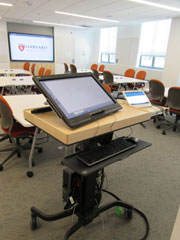
One of the new learning suites in the Medical Education Center. Image: MRF Buckley
New ways of learning require new kinds of classrooms.
The first year of Harvard Medical School’s redesigned Pathways MD curriculum, launching this fall, is built upon a foundation of flexible, case-based, collaborative learning.
Students come to class already prepared, having learned basic concepts ahead of time through online readings and brief introductory videos. They then spend class time with faculty solving problems based on those concepts.
Get more Harvard Medicine News here.
Students will spend time working in small groups of four to six, then reunite with larger groups of around 40 students to discuss their findings.
None of this would have been physically possible in the previously existing classrooms in the Medical Education Center.
“Pathways is a complete rethinking of the MD curriculum for students in the Cannon, Castle, Holmes and Peabody Societies,” said Jane Neill, associate dean for medical education planning and administration, who, with John Scully, engineering and construction project manager, spearheaded the design and construction process for four new three-room learning suites at HMS.
“To accommodate a new kind of learning, we needed a new kind of space,” she said.
The new classrooms are bright, with natural light drawn deep into the building through large exterior windows and glass interior walls. The sunshine on a recent summer day reflected off bright maple wood accents and white walls which accommodate plenty of erasable whiteboard space.
The learning studios and classrooms feature moveable, wheeled tables that can be arranged in a variety of formats. Each base unit seats two, but for team work, the tables can be clustered to seat four or more; or the whole classroom can be easily configured into a more traditional space, such as a circle of seats, to accommodate conference-room-style conversations.

Students can also create individual workstations by clicking in privacy walls. The key, Neill said, was to design spaces that could accommodate numerous learning and teaching situations.
The new suites, which have varying color schemes, such as purple, blue, green and orange, also feature cutting-edge information technology tools and cameras that will make it easier for teachers and students to share digital resources with one another or include other classes and guests at remote locations through an intuitive, simple to use interface.
“We wanted to make the space as flexible as possible for as many different uses as you can imagine, and we didn’t want technology to get in the way,” said Praneeth Machettira, director of technologies for education and online learning.
With little time to spare between the end of one year of classes and the start of the next, construction of the new classrooms had to happen quickly. In just a little more than two months over the summer, old classrooms, skills labs and tutorial spaces on the first and third floors of TMEC were transformed to meet the needs of the new curriculum.
The same afternoon that medical students finished their exams on June 5, construction workers began demolition in the old rooms. Just about eight weeks later, crews were putting the finishing touches on the four new learning suites, each of which includes a large learning studio, a small classroom and a lab room.
Just as the curriculum builds on a series of innovations that have been piloted in classrooms over the last several years, the technological infrastructure is part of an ongoing evolution.
In previous classrooms and conference rooms, Machettira said, faculty experimented with a variety of smart boards and projection systems, enabling designers to weed out tools that were ineffective, slow or confusing to work with.
The new classrooms feature high-resolution touch and stylus-driven tablets at the podium, making it easy to share multiple screens in the room or on the web.
After the initial launch of the new system, users will be able to use an app that will allow classroom participants to share from their own laptops, tablets and phones.
The goal is to make user experience simple and consistent across every room on campus, Machettira said.
While students are learning medicine, Machettira said, his team will be learning how to best deploy the new technology in other classrooms and shared spaces around campus.


